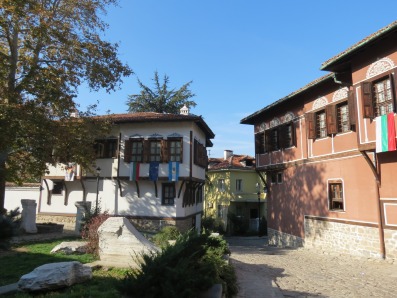The Bagpipe Society
A Weekend in Plovdiv
A Weekend in Plovdiv for the Bulgarian National Bagpipe Association’s First Conference
“No shoes on his feet – he still wants a new bagpipe” goes a Bulgarian saying, resonating probably with most of us in this bagpipe realm. The Bulgarian, sensible people, have difficulties conceiving a festive event without this wonderful instrument. As goes another expression: “a wedding without a bagpipe is like a funeral”.
These are a couple of sayings I wrote down whilst visiting Plovdiv’s ethnographic museum on Sunday 4th November, following the Bulgarian National Bagpipe Association’s first international conference on Saturday 3rd November.
The Bulgarian National Bagpipe Association (BNBA) was founded in 2017 to promote certain aspects of Bulgarian culture including, in its own words, ‘the development and the establishment of the Bulgarian folklore and traditions, preservation and developing the bagpipe art, expansion of the area for artistic expression and social realisation of performers authors and masters of the instrument, dissemination and promotion of Bulgarian and foreign artists in this area in [their] country and abroad’. Philanthropist Teodora Ignatova, also a businesswoman and Honorary Consul of Republic of Bulgaria for the Democratic Republic of Congo, was key in the creation of the association, gathering the support of pipers from all over Bulgaria to form the first national association in order to ‘value the role of the bagpipe in Bulgarian folklore and teach new representatives of the bagpipe art, promoting and exploring this instrument’.
The association is indeed impressive with already 400 members after just over a year of existence. Founding members, accompanied by Teodora, have been very proactive in organising activities and encouraging membership. A delegation formed of the association’s chairman, piper extraordinaire Petar Yanev, award-winning pipe-band leader Veselin Kozarev, the association’s secretary Asparuh Grigorov and Teodora Ignatova came to the International Bagpipe Conference in Mallorca, 2018, to scout the terrain and meet pipers from around the world. Petar and Veselin particularly impressed the IBC delegates with a soulful fifteen-minute suite of melodies from the Rhodope Mountains during the Saturday night party.

A direct consequence of their visit was the organisation of their conference in November 2018 for which they sent out invitations to pipers all over the world. Always up for a new trip, and nostalgic of my MA fieldwork in Bulgaria, studying the Bulgarian gaida, I accepted. At the time, I had spent most of my days with gaidar Petko Stefanov – who knows Jon Swayne and Michael York – a man of great humour and skill and a fantastic gaida maker. His son, Yavor Stefanov, who then was mainly carving wood and making a living as an interior designer, has now taken over the business, expanding to kaba gaida, bagpipes from the Rhodope Mountains, and kavals, Bulgaria’s open-ended flute and one of the most beautiful instruments in existence (www.stefanovmusic.com). Petko still prepares the bags and recently made a small bagpipe for his 5-year-old grandson who –for now – squeezes it with delight and produces a rather melodious wail. I remembered Plovdiv, where the conference was held, as a beautiful place with a magnificent old centre, peppered with antique amphitheatres, cobbled streets and old wooden houses. My memories were not inaccurate, if anything, they had downplayed the beauty of the town.

After a couple of days in Sofia, generously put up in a wonderful hotel by the BNBA, catching up with old friends from 11 years ago as well as visiting beautiful sites with Asparuh, the association’s secretary, I travelled down to Plovdiv at breakneck speed with Teodora on Friday 2nd November. Before stopping at Plovdiv, we met up with Petar Yanev at a petrol station and made our way to a magnificent monastery at the foot of the Rhodope Mountains. It was there that I realised how much of a celebrity Petar Yanev truly was. Recognised by everyone, he stopped and chatted to people all throughout the quick visit, welcoming every new face with a warm smile. Teodora had told me how, even on the way to Mallorca, Bulgarians were stopping him in the airport to shake his hand and take a picture with him.
After a quick tour, we eventually arrived in Plovdiv where Asparuh was waiting with Eric Montbel, well known to us all. The organisers made their way to the Academy of Arts where the conference was to be held the next day whilst Eric and I caught up over a cup of tea, overlooking a Roman stadium, excavated below Plovdiv’s main pedestrianised shopping street. We were then shown to our hotel in a wonderful old wooden house in the centre of the old town. I do not think the Bulgarians’ hospitality could be any more welcoming or delightful.
The next day, Saturday 4th November, was the conference. Eric and I arrived together, early, and found the entrance to the concert hall, where the conference was to take place, decorated with tables showing a huge range of gaida chanters with short explanations, ranging from the exquisitely decorated to the simplest of bored twigs. On the opposite side was a display of Hungarian bagpipes collected by Georg Stuber, the third international presenter of this event.
The conference was opened by chairman Petar Yanev, who greeted everyone in the room in his calm and steady voice, followed by greetings from the vice rector of the Plovdiv’s Academy of Music Dance and Fine Arts. We then heard an essay by Zoya Mikova and a paper on ‘Music in the Sacred Spaces of the Thracians’ by Professor Valeria Fol, read in absentia by Dr Georgi Mishev, one of the association’s founding members. Eric Montbel was up next for a great presentation about the chabrette and the symbolism of its mirror decorations. His talk was translated by Teodora, who, impressively, speaks over six languages. After a quick tea and coffee break accompanied by delicious biscuits, we heard a presentation by Dr Georgi Mishev entitled ‘Notions and beliefs about the bagpipe in 1st century BC in Alexandria’. This was followed by a presentation by bagpipe superstar Ivan Georgiev, also a teacher at the Academy of Plovdiv. The following week, he was making his way to Armagh and meeting up with his friend Anxo Lorenzo where I am sure they both had an excellent time.
Lunch was served at a restaurant near the academy. We were especially humbled to be seated with Valya Balkanska, the Bulgarian singer whose voice was selected to be on the Voyager Golden Record, sent into space on the Voyager Spacecraft in 1977. A delicious lunch, with local dishes ordered and shared between everyone, replenished our energy for the afternoon.

The conference resumed with a talk by Dr Iglika Mishkova, curator of the National Ethnography Museum in Sofia. She presented a paper entitled ‘The Bagpipe in the Museum’. I was unfortunately not able to chat to her as she left soon after presenting. I was then invited to talk about the acoustic/mechanic research I had carried out on the Galician and Mallorcan bagpipes during my postdoc in Paris. The full article is available in the Galpin Journal (Balosso-Bardin et al. 2018. ‘The Secret of the Bagpipes: Controlling the Bag. Techniques, Skill and Musicality’. In Galpin Society Journal 7) for those who are interested in knowing more about it. A conversation about bagpipe reeds after the presentation highlighted a palpable ongoing controversy, with adamant defenders of traditional cane and modern plastic reeds. The intense debate was thankfully broken up by the promise of tea and coffee.
The penultimate paper was presented by Dr Milko Dushkov, who talked about ‘Bagpipe Customs from the Region of Varna and Chumen’. Here we learned that only the best pipers played at weddings and that to do so was a huge honour. Pipers were so highly valued that villagers would band together to collect enough money and build the piper a house so he would stay in the village. This was necessary as the next village was offering a similar deal and it was the best way to convince a piper to stay with them.

The final paper was presented by Georg Stuber who spent his entire adult life talking to pipers in Moldavia, Hungary, Romania and Bulgaria, accompanied by his wife, collecting stories and collating them in a book. He presented an impressive and beautiful collection of instruments, adorned with wooden goat heads and decorative elements.
The conference ended in the evening at a restaurant in the old town of Plovdiv where numerous pipers joined in for the celebration. The meal, consisting of salad, rice and mutton prepared especially for the occasion, was a real success. At regular intervals, a whole table would rise and bagpipes would get inflated, interpreting lengthy suites of riveting melodies, filling the restaurant with the sound of dozens of instruments. We heard songs accompanied by pipes, we witnessed dancing to the sound of a lone piper, we heard Petar Yanev serenading a friend, we were silenced by the virtuosity of Ivan Georgiev on the higher pitched djura gaida, we were overall humbled and deeply impressed by the warmth and talent of these Bulgarian pipers, men and women with large hearts and nimble fingers. As people left, Eric and I found ourselves sipping delicious raki until 2 AM, listening to an ever-decreasing circle of pipers, sharing our music and laughter.
This extraordinary day was followed by a cultural morning visiting the ethnographic museum where I noted down the following riddle: “A flayed goat is walking through the village, And while walking, it is bleating.”

The Bulgarian adventure ends with a present. Petar Yanev met us with Teodora, Asparuh and Vesselin the following morning for coffee in Plovdiv town centre. He presented Eric and I with two small water bottles filled with his delicious homemade raki that we had sampled the previous evening. Both Eric and I were flying with hand luggage only, but we found the solution to the problem when joking around. Vesselin then spent the next half hour driving from pharmacy to pharmacy until he found what we were looking for. Upon his arrival home, Eric sent me a picture of the urine tester pots we had both used to smuggle the raki into our respective countries, breaking the 500ml bottle down to acceptable 70ml quantities. My ration is now safely home, waiting for a piping occasion to be shared amongst friends, reminding me of a wonderful weekend in Bulgaria, most warmly welcomed by the Bulgarian National Bagpipe Association.
*In the Winter 2018 edition of Chanter Eric Montbel described the portrait of Gaspard de Gueidan in the Granet Museum in Aix-en-Provence. The aristocrat is depicted playing a rare type of musette – a “musette à ravalement”, played in the begining of the 18th century. But the first musettes with double chanters were invented by Martin Hotteterre around 1660, and are very rare. There are few musettes surviving from this period but a precious example, and possibly the earliest, was studied by Eric and his colleague, the Italian zampogna and bagpipe maker and musician, Marco Tomassi. *
- Data Processing Notice (GDPR)
-
@BagpipeSociety on X (formally known as Twitter)
-
TheBagpipeSociety on Instagram
-
 BagpipeSociety on Facebook
BagpipeSociety on Facebook
Something wrong or missing from this page? Let us know!
